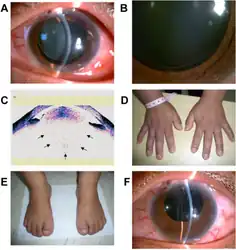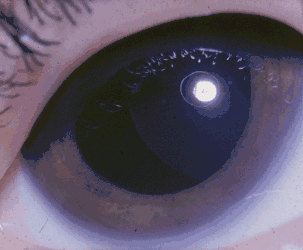Weill–Marchesani syndrome
| Weill–Marchesani syndrome | |
|---|---|
| Other names: Spherophakia-brachymorphia syndrome, congenital mesodermal dystrophy, GEMSS syndrome | |
 | |
| A six-year-old female with Weill-Marchesani syndrome, which has caused a dislocated lens. | |
| Specialty | Ophthalmology, rheumatology, medical genetics |
Weill–Marchesani syndrome is a rare genetic disorder characterized by short stature; an unusually short, broad head (brachycephaly) and other facial abnormalities; hand defects, including unusually short fingers (brachydactyly); and distinctive eye (ocular) abnormalities. It was named after ophthalmologists Georges Weill (1866–1952) and Oswald Marchesani (1900–1952) who first described it in 1932 and 1939, respectively.
The eye manifestations typically include unusually small, round lenses of the eyes (spherophakia), which may be prone to dislocating (ectopia lentis), as well as other ocular defects. Due to such abnormalities, affected individuals may have varying degrees of visual impairment, ranging from nearsightedness myopia to blindness. Researchers suggest that Weill–Marchesani syndrome may have autosomal recessive or autosomal dominant inheritance.[1]
Symptoms and signs
The clinical presentation of this condition includes: brachydactyly, short thumb, glaucoma, pulmonic stenosis, visual loss[2]
 a) Small lens, b) suspensory ligaments, c)lens is microspherophakic, d) & e), short toes/fingers ,f) phacoemulsification and intraocular lens implantation.
a) Small lens, b) suspensory ligaments, c)lens is microspherophakic, d) & e), short toes/fingers ,f) phacoemulsification and intraocular lens implantation. A lens dislocation caused by Weill-Marchesani syndrome
A lens dislocation caused by Weill-Marchesani syndrome
Diagnosis
Diagnosis is made when several characteristic clinical signs are observed. There is no single test to confirm the presence of Weill–Marchesani syndrome. Exploring family history or examining other family members may prove helpful in confirming this diagnosis.
Treatment
Eye surgery has been documented to help those with ocular diseases, such as some forms of glaucoma.[3]
Prognosis
However, long term medical management of glaucoma has not proven to be successful for patients with Weill–Marchesani syndrome. Physical therapy and orthopedic treatments are generally prescribed for problems stemming from mobility from this connective tissue disorder. However, this disorder has no cure, and generally, treatments are given to improve quality of life.[4]
See also
- ADAMTS10
- ADAMTS17
- FBN1
- LTBP2
References
- ↑ "Weill Marchesani Syndrome". WebMD, LLC. Archived from the original on 8 February 2013. Retrieved 24 December 2012.
- ↑ "Weill-Marchesani syndrome | Genetic and Rare Diseases Information Center (GARD) – an NCATS Program". rarediseases.info.nih.gov. Archived from the original on 18 March 2021. Retrieved 3 August 2021.
- ↑ Harasymowycz, P; Wilson, R (2005). "Surgical treatment of advanced chronic angle closure glaucoma in Weill-Marchesani syndrome". J Pediatr Ophthalmol Strabismus. 41 (5): 295–9. doi:10.3928/01913913-20040901-08. PMID 15478742. 15478742..
- ↑ Anderson, Charles; Anderson, N (2002). NORD Guide to Rare Disorders. USA: Lippincott Williams & Wilkins. pp. 266–267. ISBN 0-7817-3063-5.
External links
| Classification | |
|---|---|
| External resources |
|
- GeneReviews/NCBI/NIH/UW entry on Weill-Marchesani Syndrome Archived 2010-06-14 at the Wayback Machine